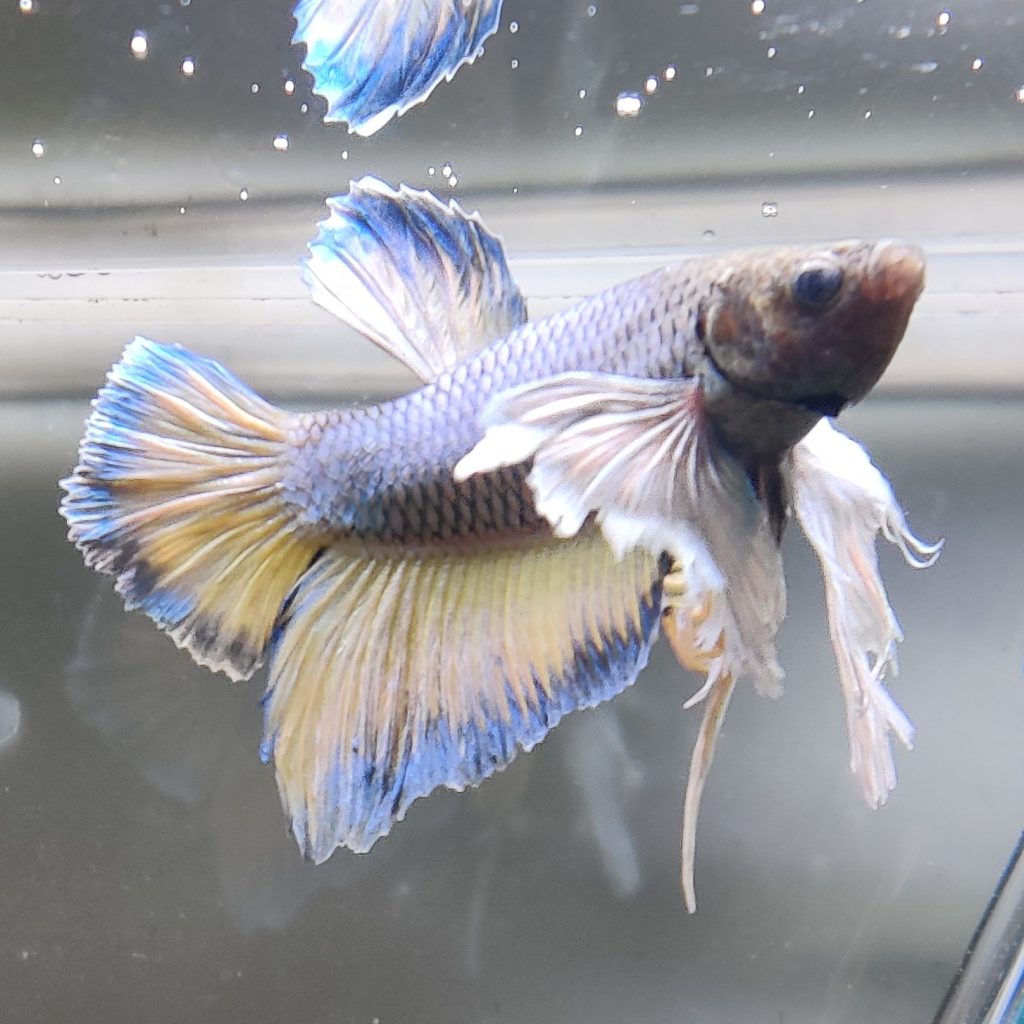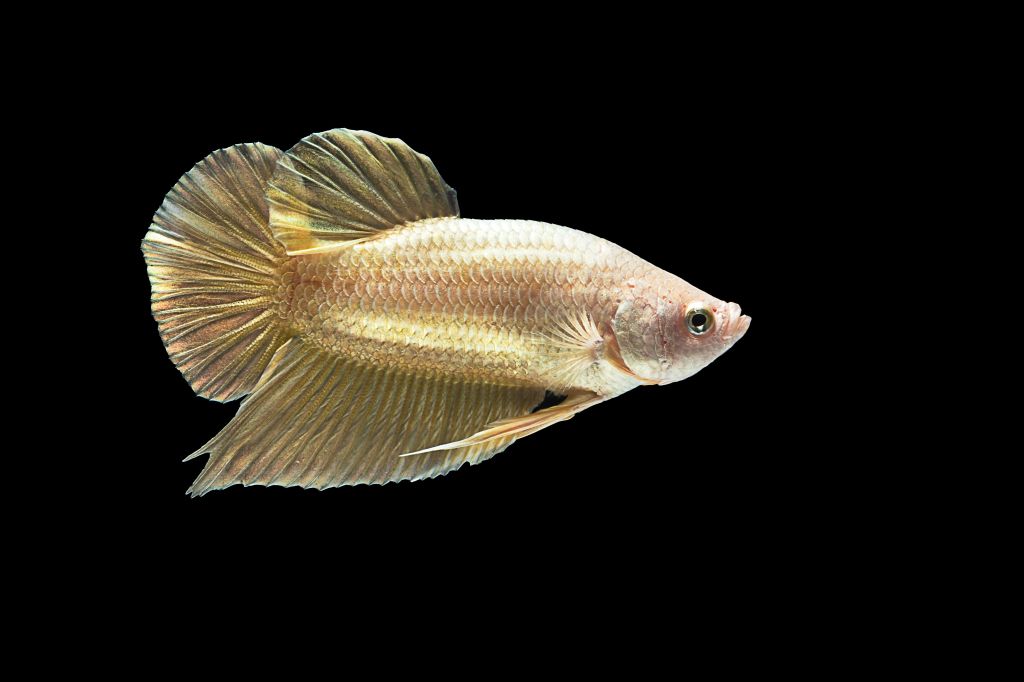As we choose betta fish mainly for their colours, it can be alarming if you start to notice that your fish is changing colour. However – some of the most dramatic colour changes can actually be for entirely harmless reasons!
Fading
If your fish fades in colour, this could be a sign that they are not feeling as well as they were when you got them – either because they are unwell, unhappy, or getting older. If your fish is relatively old, than this can’t be avoided – think of this as the fish version of getting grey hair.
However, if they aren’t, you should check their water parameters and look for any other signs of illness.
Stripes
Stripes on a betta fish are usually more common on females, and are more easily spotted on lighter colour fish than darker ones, but these are usually an expression of how your fish is feeling. There are two key types of stripes that you may see:

Vertical stripes are a sign that a female betta is ready to breed. These only affect females and not males, but even if you’re not intending to breed your female, it’s not necessarily anything to orry about if you see this.

Horizontal stripes affect both males and females, though are more likely on females. They usually appear darker than breeding stripes, and these are a sign that the fish is afraid, or stressed.
Stronger/Brighter Colour
Some betta fish are affected by what is known as a ‘marble gene’, which in part is what contributes towards their beautiful colouring.

You won’t necessarily be able to tell for sure if your fish has this gene before it actually starts to change colour, althought experienced breeders suggest that certain colours of betta are more likely to have it.
Let me introduce Skye, who was the first of my fish who had ever changed colour, and who introduced me to the concept of marbled fish that change colour (along with some helpful advice by some more experienced keepers at bettaforum.com!). Skye is shown on the right here, but this is his current colouring, not the colouring he had when I first got him!
This is Skye below, with the earliest picture of him on the left. I’d had him for 5-6 months, and he’d stayed the same throughout – but at just over 6 months I noticed these orange/brown marks on him, shown in the middle photo. On the right hand side photo (sorry for the poor lighting) that’s a week later.



To me, this colour change was so fast that I assumed that it was some kind of harm or damage – initially I thought it might be ammonia that had caused burns because the ammonia levels were slightly higher than they should be. Feeling unsure, I sought help online, and the kind people on the forums told me that it was most likely just marbling.
I was still a little unsure, but he was behaving normally, I sorted the ammonia levels, and his orange patches continued to darken. Fortunately, 3 months later and he’s still absolutely fine, very healthy, and just as happy as he was before! And curiously, though the patches stopped growing around the picture on the right, and became fairly stable – since then they have actually faded a little bit again, more on one side than the other.
If you’d like to know more about marbling and the marble gene there’s a very good guide here: https://badmanstropicalfish.com/betta-fish-marbling/. The most important thing is that if you have a marbled fish and it’s changing colour – once you can be sure that it’s definitely marbling and nothing else – it isn’t in any way harmful for the fish, and they will be as happy and healthy as they were before!
Maturing/Getting Healthier
If your fish started a lighter colour and started to darken or become brighter, it’s quite possible that they are maturing, or getting happier!
Here is a lovely time lapse set of photos of the same fish, becoming darker, bluer and brighter, having started out white. Many fish are sold at around 6 months, so they still have time to mature and colour up. That noted however, usually a seller will get a higher price with a fish that is fully coloured, so it is not necessarily that any fish you buy will be getting brighter.


On the other hand, it’s actually very common for someone to buy a betta that is unhappy with its conditions and environment when they bought it – perhaps kept in a ‘cup’, with an owner who doesn’t know how to take care of it, or in a pet store that isn’t taking proper care of their fish. Again if you get a fish delivered, you will find that many sellers will include a note of warning that your fish may be pale when it arrives, but it will colour up when it calms down and settles in.

The picture above is a good example of this in progress. On the left, you have a pale blue, perhaps lavendar coloured fish, with transparent fins and a pale belly. On the right is the same fish, but this time he’s happy! All of his fins are darker and blacker, and the pale shimmer has turned into a beautiful royal blue with black freckles!
The most important thing to deal with if your fish changes colour is whether they are in any danger, if their health is threatened.
Firstly, check your water parameters. Bad water conditions can trigger a lot of issues, and with any change in your fish you should check them and rectify any issues.
Secondly, if there is any doubt about whether it is a colour change, consider whether it could be anything else – parasites, rust, burns, physical damage? If you’re certain it is a colour change, think about what kind of colour change it is.
Are your fish’s colours fading, or becoming duller or greyer? This is a common sign that either they are unhappy, ill, or perhaps they are just getting a bit older, but this is unlikely to be sudden.
Are your fish’s colours getting brighter, or changing colour entirely, possible to blue, white, red or purple? This could be down to the marble gene, or possibly just because your fish is happier than he was!


